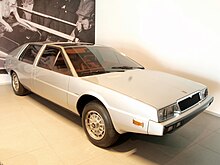Maserati Medici
The Maserati Medici is a concept vehicle that the Turin design studio Italdesign developed in the 1970s on the basis of a Maserati and which was produced in 1974 and 1976 in two slightly different copies as Medici I and Medici II . The design of the car goes back to the designer Giorgio Giugiaro . The Medici influenced the outer shape of numerous production vehicles from the late 1970s. Its name is reminiscent of the Florentine family of the same name , which was one of the most influential families in Italy during the Renaissance .
concept
The Maserati Medici was a design study for a luxury class sports sedan. Both versions of the Medici were designed as a four-door hatchback sedan with a front engine. They were built on the extended platform of the Maserati Indy ; the drive was a 4.9 liter Maserati engine installed lengthways at the front. Both copies were ready to drive.
Medici I
The Medici I was created in the spring of 1974. The vehicle had a horizontal belt line in the passenger compartment.
A characteristic feature of the Medici I was a trapezoidal C-pillar which was very narrow towards the roof and many times wider at the bottom. Overall, the impression arose as if the rear of the car was tapering towards the top. This shape has often been associated with a boomerang . These lines were found in numerous production vehicles that Giugiaro later designed. In some of them, such as the Lancia Delta I or the Audi Coupé (B2) , the C-pillar was made of sheet metal, other vehicles such as the Audi 80 (B2) or the Yugo Florida had an additional trapezoidal window in the C-pillar.
The front end of the Medici I was very similar to the (nameless) Maserati Coupé 2 + 2 , also designed by Giugiaro in 1972 , which had been discussed as the successor to the Indy. It was pointed and had pop-up headlights .
Inside, the Medici I was designed as a six-seater. Behind the two front seats were two bench seats installed opposite one another; the passengers in the middle row were seated against the direction of travel. In any case, the space available was cramped when the fund was fully occupied. One passenger's knees touched the lower body of the passenger seated opposite.
The Medici I was shown to the public for the first time in April 1974 at the Turin Motor Show . It belongs to the collection of the Louwman Museum in The Hague.
Medici II
In contrast to the Medici I, the Medici II presented in 1976 was a pure four-seater. Outwardly, it differed from its predecessor only in the design of the front section. Instead of the sloping line of the Medici I, the Medici II had a high front section. In fact, the front fenders on the Medici II fell off towards the front; however, the angle of inclination was significantly smaller than that of the predecessor. The impression arose as if the front section continued the horizontal belt line. At the front of the car were four high-set square headlights that framed a square, chrome-framed radiator grille. With the high front section, Giugiaro took up a design feature that he first realized in the De Tomaso Mangusta and was first found on a mass-produced vehicle in the 1974 VW Golf I.
The Medici II is considered the stylistic predecessor of the Maserati Quattroporte III , which was presented in 1976 and in series production from 1979. The DeLorean DMC-12 is stylistically a two-door version of the Medici II; numerous features of Medici II were adopted for him. The same applies to the four-door Lancia Delta I, which is a shortened version of the Medici II. The high front section was also found in many other vehicles that Giugiaro developed in the late 1970s, including the Audi Coupé. The Maserati Biturbo Coupé designed by Pierangelo Andreani also took up the Medici lines. The American Ford group adopted elements of the front design for the second version of the Mercury Capri .
The Medici II was exhibited at the Paris Motor Show in 1976 and sold in 1977 to Mohammad Reza Pahlavi , the Shah of Persia , who had a penchant for Maserati models. The car is now in the Louwman Collection in The Hague .
Gallery: Production vehicles influenced by the Maserati Medici
literature
- Martin Buckley: Maserati. Italian luxury and flair . Heel Verlag, Königswinter 2012. ISBN 978-3-86852-633-2 .
- Cancellieri, Gianni, et al. (Ed.): Maserati. Catalog raisonné 1926–2003 . Automobilia. Milan 2003. ISBN 88-7960-151-2 .
- Lange, Hans-Karl: Maserati. The other Italian sports car . Vienna 1993. ISBN 3-552-05102-3 .
Web links
Individual evidence
- ↑ a b c Lange: Maserati. The other Italian sports car , p. 50 f.
- ↑ For the Coupé 2 + 2 cf. Lange: Maserati, p. 50.
- ↑ Illustration of the Maserati Medici I (accessed on August 11, 2013)
- ^ Illustration in Buckley: Maserati, p. 125.
- ↑ Richard M. Langworth: Encyclopedia of American Cars 1930–1980. New York (Beekman House) 1984. ISBN 0-517-42462-2 , p. 464 ff.
- ^ Buckley: Maserati. P. 124.







